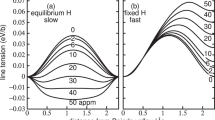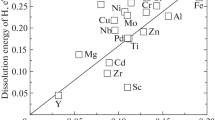Abstract
The difference between the chemical potentialμ σ of hydrogen atoms producing a nonspherical symmetry strain in a solid sample under stress and that μ0 corresponding to the state without stress has been calculated. It is shown that μσ - μ0 = -VΣiσiε ′ii =U whereσ i stands for principal stress,ε ′ ii for the strain component along the direction of the principal stress,V for volume, andU is the interaction energy between the strain field and external stress field. The hydrogen atoms producing the tetragonally symmetric strain are preferentially ordered in samples under stress. As a result, the variation of hydrogen concentration with tensile stress σ will be different from that with compressive stressσ*. For a general polycrystal the formulas are, respectively,C ten =C 0 exp[(0.70089ε11 + 0.2991lε22)Vσ/RT]andC com =C 0 exp[(0.14956ε11 + 0.85044ε22)Vσ*/RT], whereC ten.,C com., andC 0 are, respectively, the hydrogen concentrations under tensile stress, compressive stress, and without stress; R stands for the gas constant andT for absolute temperature. Hence, ε11/ε22 may be determined in terms ofC ten/C com which can be obtained by hydrogen permeation measurement. For example, according to Bockris' data ε11/ε22 = 1.27 at temperature of 27 °C which implies that the strain field of hydrogen atoms inα-Fe is nonspherical symmetry. For a torsional stressτ,U tor = -0.55133V τ(ε11 ε22. The interaction can result in the enrichment of hydrogen atoms on and hydrogen induced delayed cracking along the planes inclined at an angle ofα = 45 deg to torsional axis, which was observed in precharged smooth torsional or type III cracked specimens made of ultra-high strength steel.
Similar content being viewed by others
References
J. P. Hirth:Metall. Trans. A, 1981, vol. 12A, p. 861.
J.C.M. Li, R.A. Oriani, and L. S. Darken:Zeitschrift für physikalische Chemie. Neue Folge, 1966, vol. 49, p. 271.
H. P. Van Leeuwen:Corrosion, 1976, vol. 32, p. 34.
R. A. Oriani and P. H. Josephic:Acta Metall., 1977, vol. 25, p. 979.
W. Y. Chu, S. Q. Li, and C. M. Hsiao:Acta Metall. Sinica (China), 1982, vol. 17, p. 10.
W. Y. Chu, S.Q. Li, C.M. Hsiao, and S. Y. Ju:Corrosion, 1981, vol. 37, p. 514.
C.S.T. John and W. W. Gerberich:Metall. Trans., 1973, vol. 4, p. 589.
W. Y. Chu, C. M. Hsiao, S. Y. Ju, and C. Wang:Corrosion, 1982, vol. 38, p. 446.
W. Y. Chu, C. M. Hsiao, C. Wang, and S. Y. Ju:Acta Metall. Sinica (China), 1982, vol. 18, p. 515.
W. Y. Chu, T. Y. Zhang, and CM. Hsiao:Corrosion, 1984, vol. 40, p. 197.
J. O. M. Bockris, W. Beck, M. A. Genshaw, P. K. Subramanyan, and F. S. Williams:Acta Metall., 1971, vol. 19, p. 1209.
J.C.M. Li:Metall. Trans. A, 1978, vol. 9A, p. 1351.
J. O. M. Bockris and P. K. Subramanyan:Acta Metall., 1971, vol. 19, p. 1205.
J. P. Hirth:Stress Corrosion Cracking and Hydrogen Embrittlement of Iron Base Alloy, R.W. Staehleet al., eds., NACE, Houston, TX, 1977, p. 1.
Author information
Authors and Affiliations
Rights and permissions
About this article
Cite this article
Zhang, TY., Chu, WY. & Hsiao, CM. Tetragonal distortion field of hydrogen atoms in iron. Metall Trans A 16, 1649–1653 (1985). https://doi.org/10.1007/BF02663020
Received:
Issue Date:
DOI: https://doi.org/10.1007/BF02663020




